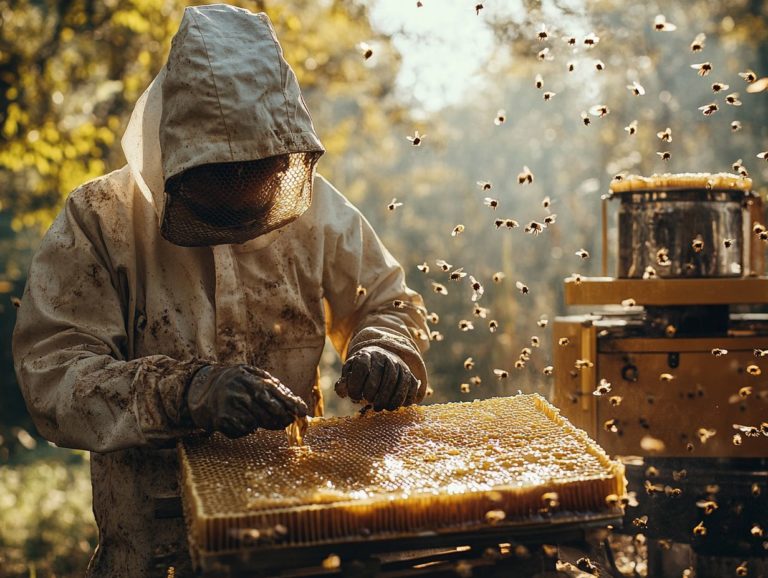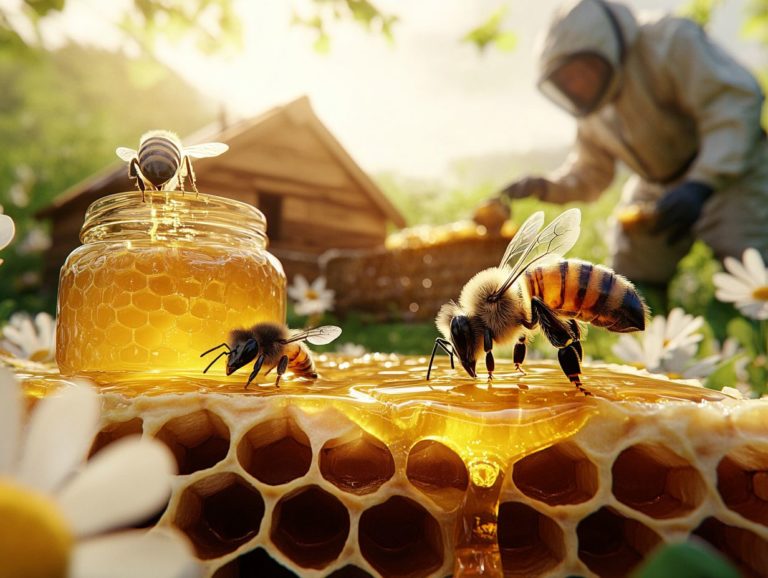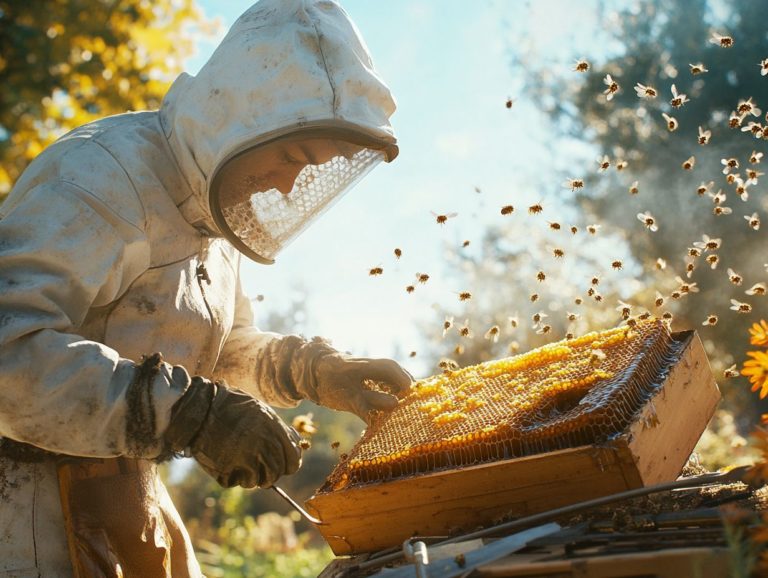The Honey Production Process: A Step-by-Step Guide
Honey production is a captivating fusion of art and science, turning the diligent efforts of bees, particularly worker bees, into a delectable natural sweetener.
This step-by-step guide will take you through the entire honey-making journey, from the moment you harvest the honeycomb to the final stages of bottling and labeling your exquisite product, ensuring the highest honey quality.
You ll uncover essential tools, master techniques for extracting and filtering honey, and gather invaluable tips for maintaining quality and hygiene throughout the process.
Whether you re an aspiring beekeeper or simply intrigued by the art of honey-making, this guide provides all the insights you need.
Contents
Key Takeaways:
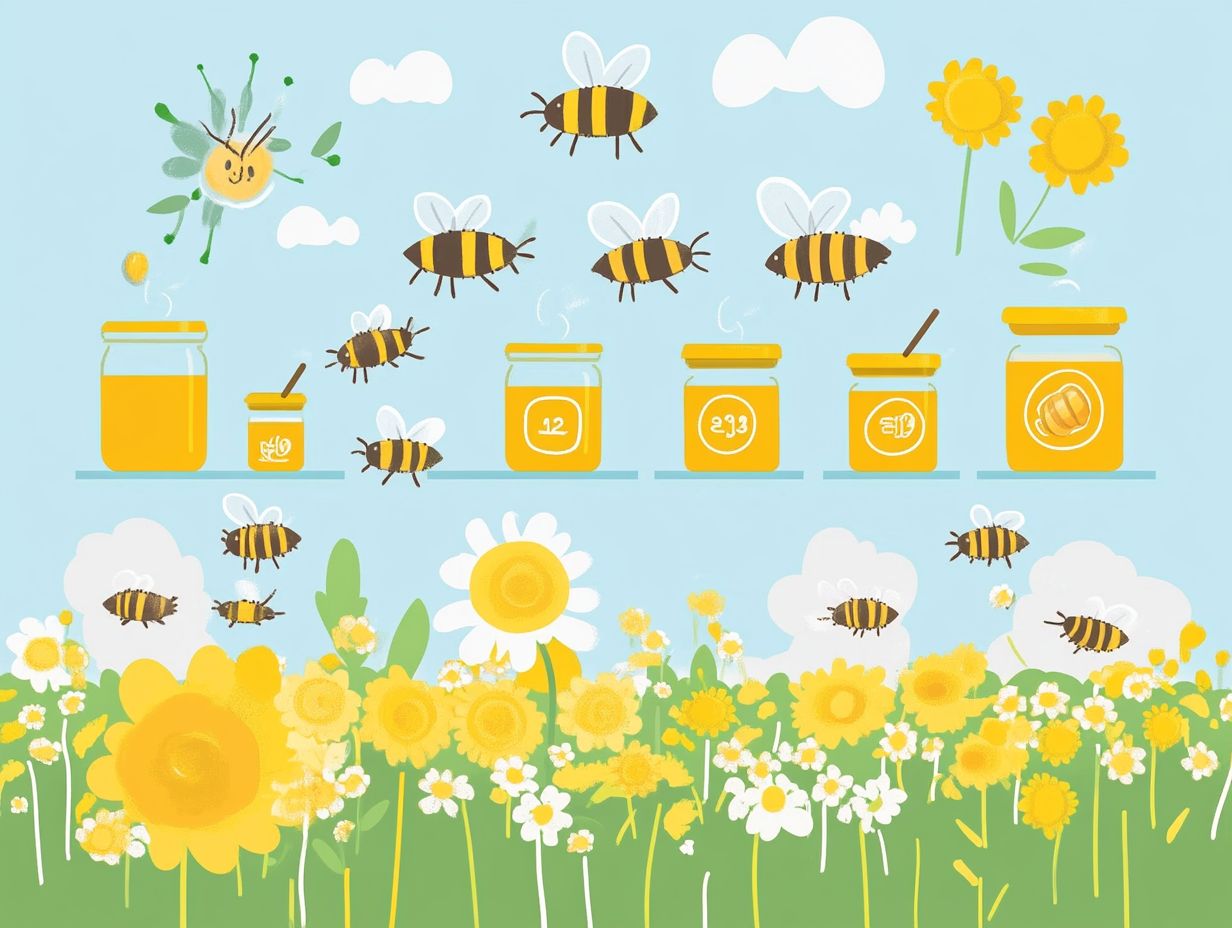
- The honey production process involves harvesting honeycomb, extracting the honey, filtering and straining it, bottling and labeling it, and selling it.
- Proper equipment and techniques are crucial for each step of the process, from harvesting tools to hygienic bottling and labeling methods, ensuring the best honey storage practices.
- To prevent common issues such as crystallization or contamination, producers must prioritize hygiene and use proper storage and labeling methods to ensure high-quality honey that retains its natural antibacterial properties.
What is Honey Production?
Honey production is a captivating natural process that showcases the remarkable teamwork of honeybees, particularly the diligent worker bees. These industrious insects venture out to gather nectar from flowers and expertly transform it into honey through their enzymes and specialized honey stomachs.
Within the sanctuary of their hive, the nectar undergoes a meticulous journey of evaporation and capping, ultimately becoming the delightful, viscous substance we know as honey. The flavor, color, and texture of honey can vary significantly based on the floral sources from which the nectar is collected, offering a delicious reflection of the biodiversity and ecosystem in which these bees thrive. The process also involves the transformation of nectar through enzymes in the honey stomachs of the worker bees.
Step 1: Harvesting the Honeycomb
Harvesting the honeycomb is the crucial first step in the art of honey production. Here, you ll find yourself delicately extracting those hexagonal cells brimming with golden honey from the hive, ensuring the preservation of the beeswax structure.
This meticulous process demands a deep understanding of bee behavior, including the roles of the queen bee and drone bees. This allows you to minimize any disruption to the hive population while skillfully collecting the sweet rewards crafted by the diligent worker bees.
What Tools are Needed for Harvesting?
To successfully harvest honeycomb, you need specific tools that will aid you in the safe and efficient extraction of honey from the hive. Essentials like a bee smoker, hive tool, and uncapping knife are crucial. These tools help you manage the bees with minimal stress and damage to the hive, allowing for the careful removal of the beeswax honeycomb structure and maintaining the honey quality.
A honey extractor is essential for spinning out honey from the comb without causing any damage, which helps preserve the integrity of the beeswax for future use. Additionally, a filtering system can be quite beneficial for removing any residue, including pollen and propolis, ensuring that you end up with a pure product.
Don’t forget about protective gear. Gloves and a veil are your best friends, safeguarding you from any stings during the process. You’ll also need buckets and containers to collect and store that liquid gold before bottling it up. These measures ensure your safety while preserving the quality of the honey.
Each of these tools plays a vital role in enhancing your beekeeping practices and ensuring a bountiful, high-quality honey harvest.
How to Properly Remove the Honeycomb?
Removing honeycomb from the hive requires a careful technique to minimize disturbance to the bees and ensure a clean honey extraction. First, you ll want to employ a smoker to soothe the bees, creating a calm environment. Then, gently pry open the frames containing the honeycomb before uncapping the cells, allowing the rich honey to flow out smoothly while preserving the beeswax for future use. This process also ensures the preservation of the natural properties of honey.
Along with using the smoker, donning protective clothing is essential for your safety while working around the colony. Once the bees are calmed, inspect the frames for capped honey, which signals that it s ripe for harvest. Uncapping can be accomplished with a specialized fork or knife, but be sure to exercise caution to avoid harming the bees and ensure the quality of your harvest.
After you ve extracted the honey, it s wise to gently return the frames to the hive, allowing the bees to clean up any leftover honey and maintain a harmonious environment. This helps in sustaining their food source. Throughout the process, be vigilant and observant of the bees behavior. If they seem agitated, it may be prudent to pause and give them a moment to settle down.
Step 2: Extracting the Honey
The extraction of honey stands as a pivotal moment in the honey production journey, where the harvested honeycomb undergoes processing to separate that delightful liquid gold from the beeswax.
This stage typically employs specialized equipment, like honey extractors, which harness centrifugal force to efficiently spin the honey out while preserving the integrity of the wax and ensuring maximum sugar content.
This method ensures that you retrieve the maximum amount of honey without compromising the quality of the beeswax.
What Equipment is Used for Extracting?
Essential equipment for extracting honey includes honey extractors, uncapping tools, and filtration devices, each crafted to ensure a smooth and effective honey extraction experience. These tools are pivotal in collecting honey without contamination, preserving its natural flavors, antibacterial properties, and health benefits.
The honey extractor stands out as the most critical piece of equipment in your arsenal. It employs centrifugal force to gently remove honey from the comb while minimizing any damage to the delicate structure. Uncapping tools, such as knives or forks, allow you to deftly remove the wax caps sealing the honey cells, granting you access to the sweet treasure within, maintaining the honey’s natural composition.
On the filtration front, devices like strainers or fine mesh filters play an essential role by eliminating impurities and beeswax particles, guaranteeing that your final product is clean and pure. Together, these instruments not only streamline your honey extraction process but also enhance the overall quality of the honey, making them absolutely essential to your beekeeping operation and ensuring the honey’s health benefits and therapeutic qualities.
How to Properly Extract the Honey?
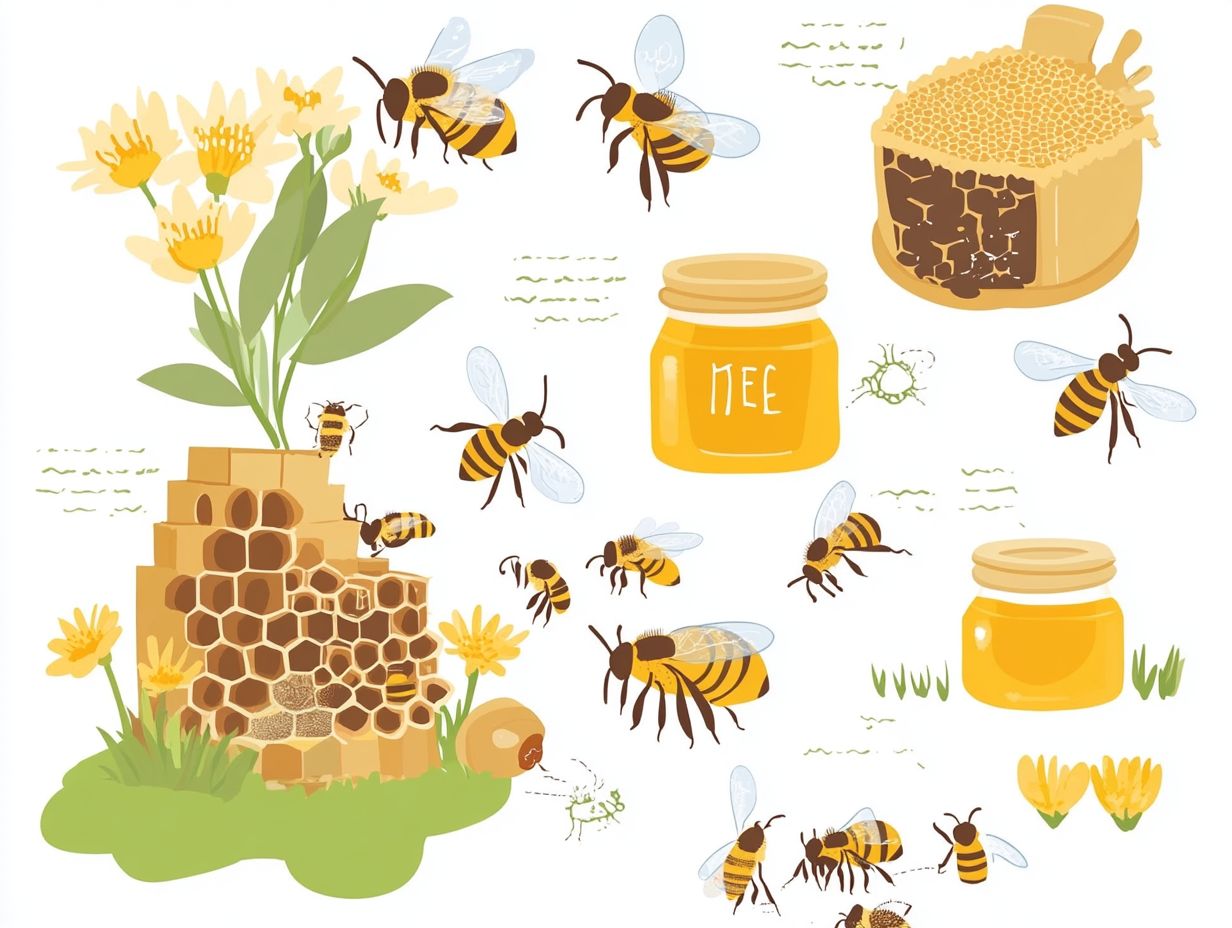
To extract honey properly, you should follow a series of systematic steps that begin with ensuring hygiene and readiness of all your equipment. Start by uncapping the honeycomb and then place it into the honey extractor. This method not only maximizes your honey yield but also preserves its natural properties and flavors.
Before you dive into the extraction process, it s essential to don your protective gear and meticulously clean your tools to avoid any chance of contamination.
Once the honeycomb is uncapped, using a heat-controlled honey extractor will allow you to spin the frames efficiently, harnessing centrifugal force to separate the honey from the wax cells.
After extraction, allowing the honey to settle in a tank is crucial. This step ensures that any impurities rise to the surface, resulting in a clearer final product.
Straining the honey through fine mesh filters out any unwanted particles, guaranteeing a high-quality end result that showcases the rich characteristics of the nectar sources, including its sugar content and antioxidants.
Step 3: Filtering and Straining the Honey
Filtering and straining the honey is an essential step in the production process, allowing you to remove impurities like beeswax particles and pollen. This meticulous approach ensures the clarity and quality of the honey you enjoy, enhancing its natural sweetness and energy-boosting properties.
By undertaking this process, you not only preserve the honey’s exquisite taste but also maintain its antibacterial properties and health benefits, ensuring it is both delightful to consume and effective in preservation. This makes honey a valuable natural medicine.
Why is Filtering and Straining Important?
Filtering and straining honey is essential for eliminating unwanted impurities that could compromise its taste and texture, resulting in a smoother, more delightful product. This meticulous process not only preserves honey’s natural health benefits such as its antioxidants and antibacterial properties but also makes it a valuable addition to your diet as a natural sweetener.
When particles like beeswax, pollen, and propolis are present, they can detract from the sensory experience you expect from high-quality honey. By carefully filtering and straining the honey, producers enhance its clarity and consistency, ensuring you receive a premium product that meets your expectations.
This attention to detail not only protects the integrity of the honey’s flavor but also extends its shelf life, allowing you to savor its rich taste and therapeutic qualities over time. Ultimately, this commitment to filtering and straining reflects a dedication to quality that sets the finest honey apart from the rest, especially considering the seasonal variations in nectar collection.
What Materials are Used for Filtering and Straining?
When filtering and straining honey, you’ll typically rely on common materials like fine mesh sieves, cheesecloth, and specialized filtering equipment. These tools are crucial for ensuring that the honey you extract remains pure and retains its natural properties, exquisite flavor, and health benefits, making it a valuable food source.
Fine mesh sieves act as your first line of defense, expertly capturing larger particles like wax fragments and bee debris while allowing that liquid gold to flow freely. Cheesecloth, with its softer texture, usually comes into play in the next stage, helping to eliminate smaller impurities and resulting in a clearer final product.
For those seeking a more refined approach, advanced filtering systems utilizing activated charcoal or ion exchange resins can effectively remove finer particulates and contaminants, enhancing the cleanliness of your honey. Together, these tools not only maintain the visual allure of your honey but also preserve the delicate flavors and aromas that the bees have lovingly infused into their nectar.
Step 4: Bottling the Honey
Bottling honey marks the final step in the exquisite journey of honey production. At this stage, you will place high-quality honey into carefully selected containers that not only preserve its rich flavor and delightful texture but also safeguard its remarkable health benefits.
While the options for containers may vary, it is crucial that they provide proper sealing and protection from light and air, ensuring the honey retains its natural properties for an extended period.
What Types of Containers are Used for Bottling?
When it comes to bottling honey, you have a variety of containers available, including glass jars, plastic squeeze bottles, and metal tins. Each option has its own unique benefits for preservation and usability.
Glass jars are preferable for their non-reactive nature, which helps maintain the purity and flavor of honey. In contrast, plastic bottles offer the convenience that many consumers appreciate.
However, each container comes with its own set of trade-offs that can impact honey quality over time. For example, metal tins may react with honey s acidic components, which can alter its taste and nutritional value. Plastic squeeze bottles are lightweight and durable, but if they aren’t made from food-safe materials, they might lead to honey crystallization or degradation.
While glass is heavier and more fragile, it is often considered the gold standard for honey storage. It prevents air and moisture from getting in, ensuring the longest preservation of honey’s exquisite properties.
By weighing these factors carefully, you can make informed choices about the best bottling method to suit your needs, whether you re a beekeeper or simply a honey enthusiast.
How to Properly Store Bottled Honey?
To store your bottled honey properly, place it in a cool, dry place away from direct sunlight. Sunlight can diminish honey’s quality over time. Maintaining these optimal storage conditions helps preserve the natural flavors and health benefits of honey, allowing it to remain a delightful and nutritious sweetener for an extended period.
Aim for a stable temperature between 50 F and 70 F. This range is ideal because extreme heat can alter both flavor and color, while chillier environments might lead to crystallization.
Keep your honey in airtight containers to prevent moisture absorption and contamination, both of which can compromise its purity. Avoid storing it near strong-smelling foods since honey tends to absorb odors.
By following these best practices, you can savor the rich taste and health benefits of honey for many years. Don t miss out on enjoying your honey for years!
Step 5: Labeling and Selling the Honey
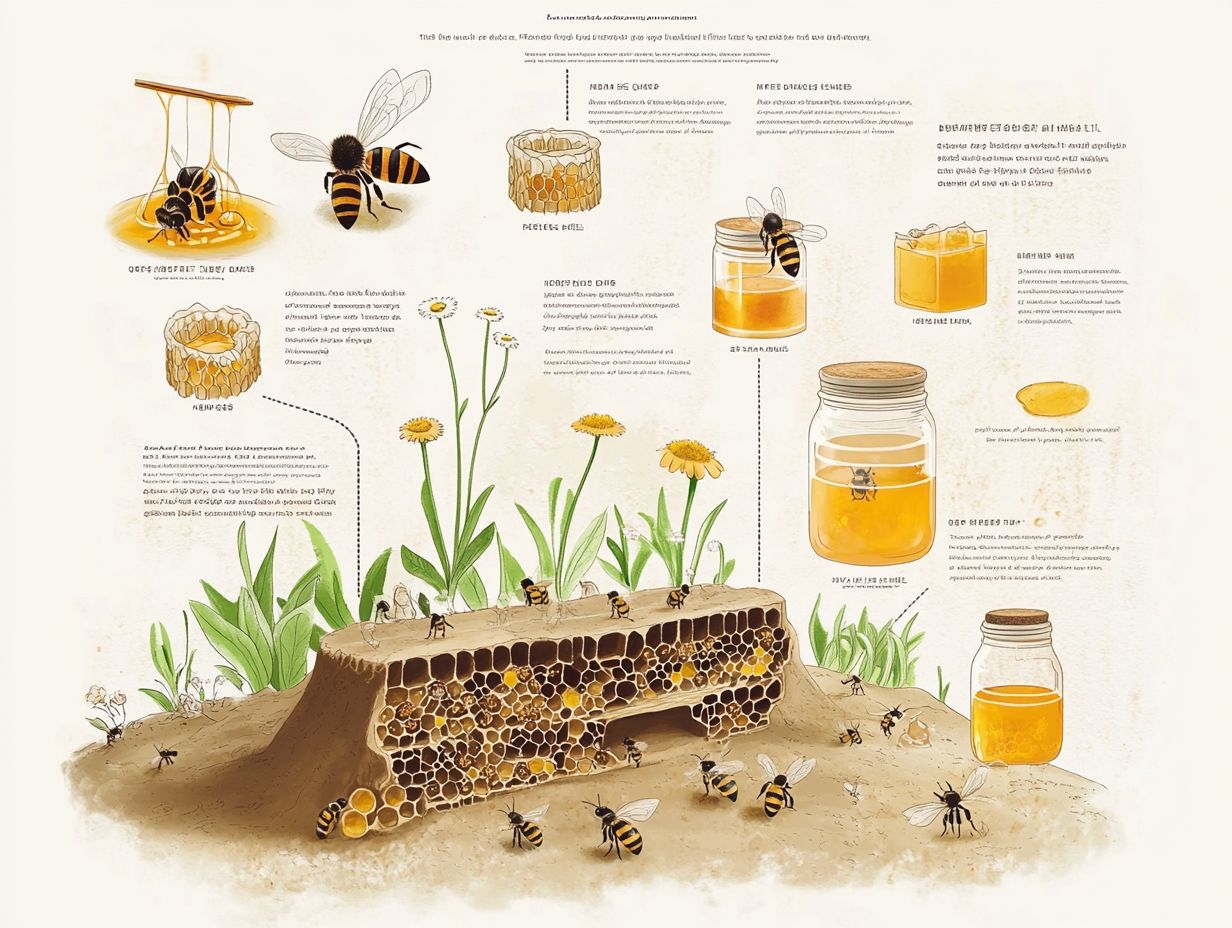
Labeling and selling honey is a crucial step in the honey production process. It not only promotes the product but also provides essential information regarding its quality and origin.
When done effectively, labeling significantly enhances the marketability of your honey. It informs consumers about its floral sources, health benefits, and any unique characteristics it may possess.
This attention to detail elevates your product and fosters trust and connection with your customers.
What Information Should be Included on the Label?
- Ingredients
- Floral source
- Batch number
- Health benefits
Including these details enhances transparency and fosters trust in the product s quality and authenticity.
For instance, specifying the floral source helps customers understand the honey’s taste profile and potential health benefits, such as its ability to soothe allergies or aid digestion.
Displaying the batch number assures traceability, which is especially relevant in a market where authenticity can vary significantly.
Clear labeling also highlights any certifications like organic or raw which can appeal to health-conscious consumers.
All these factors contribute to a more educated consumer base, empowering you to select products that align with your dietary preferences and values. This ultimately deepens your connection with the brand.
Start labeling your honey today and connect with your customers!
How to Market and Sell the Honey?
To effectively market and sell honey, implement strategies that showcase its unique qualities, such as local sourcing, organic certification, and an array of health benefits. Building a robust brand presence through social media, farmer’s markets, and partnerships with local businesses greatly enhances visibility and draws in more customers.
Utilizing storytelling to forge an emotional connection with consumers illuminates the journey of honey from hive to jar, making your product even more appealing. Engaging with the local community through workshops and tastings demonstrates the versatility of honey in various culinary applications while educating buyers about its sustainable benefits.
Creating visually stunning content on platforms like Instagram and TikTok encourages social sharing, significantly amplifying your reach. Collaborating with influencers in the health and wellness niche drives traffic and conversions, transforming casual browsers into dedicated honey enthusiasts.
Common Issues and Solutions in Honey Production
Honey production can pose several challenges, such as crystallization, contamination, and hygiene concerns. Each of these issues demands tailored solutions to uphold quality and safety.
Understanding these issues and knowing how to tackle them effectively is vital for anyone seeking success in beekeeping and honey production.
How to Prevent Honey from Crystallizing?
To prevent honey from crystallizing, ensure it is stored at room temperature and away from moisture. High sugar content and temperature fluctuations can trigger crystallization, so maintaining the best way to store honey is key to preserving its texture and quality.
Beyond providing a stable storage environment, it’s essential to understand the chemical properties of honey. Primarily composed of sugars found in honey, changes in temperature can disrupt their balance and promote crystallization.
Consider using airtight glass containers to minimize exposure to air and moisture, which can compromise honey’s purity and flavor. Keep your honey between 18 and 24 degrees Celsius for best results to maintain its viscosity and prevent the formation of sugar crystals.
By embracing these strategies, you can ensure that your honey remains a smooth, high-quality product that continues to delight consumers.
What to Do if Honey is Contaminated?
If you think your honey is contaminated, act fast to find the source and fix it. This could mean filtering, re-extracting, or even discarding compromised honey to ensure both safety and quality. Regular testing and quality checks are essential in honey production to prevent contamination issues.
To effectively manage potential contamination, begin with a thorough examination of your production environment. Ensure that your equipment and storage areas are spotless and free from any pollutants. Implementing preventive measures, such as using food-safe containers and maintaining optimal storage temperatures, can greatly reduce the risk of contamination.
It s equally important to train your personnel in safe handling practices. This empowers them to recognize the early signs of compromised batches, allowing for quicker interventions. If contamination is detected, prompt testing for pesticide residues or microbial contamination is essential. This enables you to make informed decisions about whether to salvage or discard affected products.
Lastly, continuous education on regulations and standards enhances the overall integrity of your honey production process, ensuring that you maintain the highest quality and safety standards.
Start using these tips today to make your honey the best it can be!
How to Ensure Proper Hygiene in the Production Process?
Maintaining proper hygiene in honey production is essential. Start with clean equipment, excellent personal hygiene, and regularly sanitizing workspaces to prevent honey contamination.
These practices safeguard honey quality and protect the health of both bees and consumers.
Regularly inspect and clean your beekeeping tools, such as extractors and bottling equipment. This removes wax, propolis, and sugar crystals that can build up.
Ensure your protective clothing is spotless; it s vital for your beekeeping success!
Following best hygiene practices reduces the risk of bacteria or mold contamination. This way, you promote not just the safety of your honey but also the well-being of your bees.
Prioritize learning about hygiene procedures. This knowledge gives you the power to deliver honey that reflects the purity of your hive.
Frequently Asked Questions
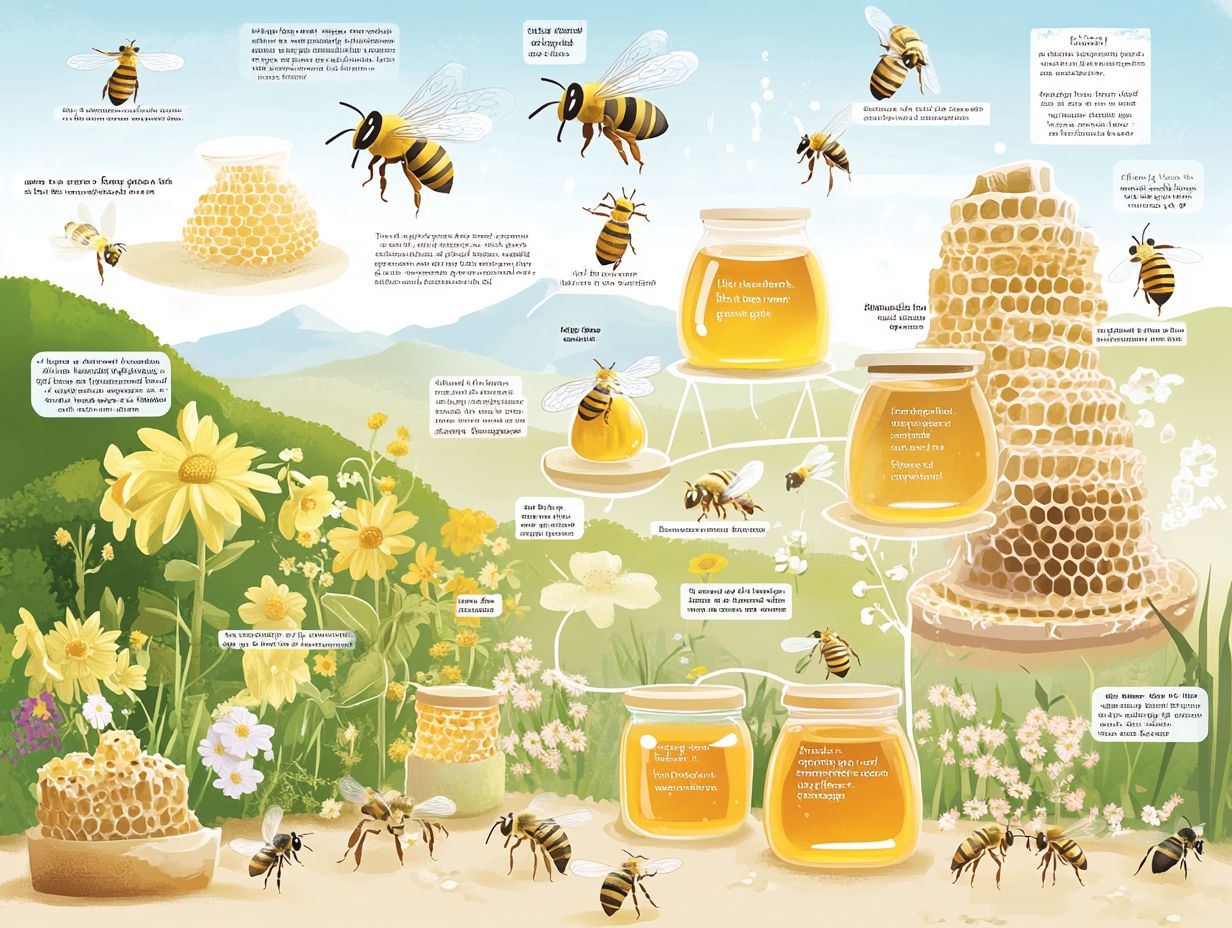
What is the honey production process?
The honey production process involves several steps: collecting honeycomb frames, extracting honey, filtering it, and bottling.
How do bees produce honey?
Bees produce honey by gathering nectar from flowers and storing it in their honey stomachs. The nectar is then transferred to other bees until it is deposited into honeycomb cells, where it is fanned with wings to remove excess moisture and turn it into honey.
How is honey extracted from beehives?
Honey is extracted from beehives using a special tool called a honey extractor. This machine spins the honeycomb frames at high speed, causing the honey to fly out and collect at the bottom of the extractor. The frames are then returned to the beehive for the bees to refill.
What is the purpose of filtering honey?
Filtering honey helps to remove impurities such as beeswax, propolis, and pollen that may be present. This results in smoother and clearer honey with a longer shelf life. However, some people prefer unfiltered honey for its natural health benefits.
Why is bottling an important step in the honey production process?
Bottling is the process of transferring honey from the extractor to jars for storage and consumption. Proper bottling ensures quality and prevents crystallization, allowing honey to last for years without spoiling.
What are some common challenges in the honey production process?
One of the main challenges in honey production is dealing with bee stings and managing bee colonies. Weather conditions and nectar availability can also affect honey production. Beekeepers need to be knowledgeable and prepared to handle these challenges.

